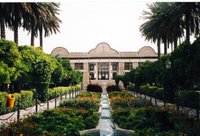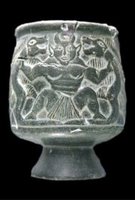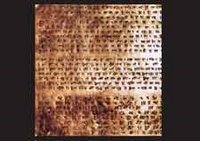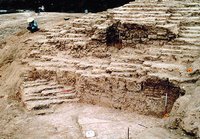Narenjestan-e- Ghavam ( Qavam's House)
 Narenjestan is not an old complex in comparison with other brilliont buildings of ancient Iran, but one look at this structure will lead to a love affair with the Iranian architect and art. Narenjestan is located in Shiraz and it's the perfect stop on a hot summer day as the gardens will refresh your very soul. The building has been occupied by many but the original builder was Mirza Ibrahim Khan who built this amazing complex in late 1800s. Mirza Ibrahim khan was the great grandson of the elder "Ghavam" and grandfather of the contemporary "Ghavamolmolk". The Ghavam family were merchants originally from Qazvin. But they soon became active in the government during the Zand Dynasty, followed by the Qajar and Pahlavi Dynasty.
Narenjestan is not an old complex in comparison with other brilliont buildings of ancient Iran, but one look at this structure will lead to a love affair with the Iranian architect and art. Narenjestan is located in Shiraz and it's the perfect stop on a hot summer day as the gardens will refresh your very soul. The building has been occupied by many but the original builder was Mirza Ibrahim Khan who built this amazing complex in late 1800s. Mirza Ibrahim khan was the great grandson of the elder "Ghavam" and grandfather of the contemporary "Ghavamolmolk". The Ghavam family were merchants originally from Qazvin. But they soon became active in the government during the Zand Dynasty, followed by the Qajar and Pahlavi Dynasty.The complex includes the private bath house, public bath house, Husseinieh (religio
 us ceremonies building, detention house and stable. The detention house and stable no longer exist. The buildings were interconnected by an underground passage way. The Qavam "Naranjestan" preserves the elegance and refinement enjoyed by the upper class families during the nineteenth century. The paintings on the low ceilings of the house are inspired by Victorian era Europe. Every room has its own theme identified by paintings on the ceilings, walls and fire places. For me the most beautiful of all the rooms was the mirror porch, which is also the focal point of the house, overlooking onto the gardens lined with date palms and flowers. There is nothing more peacfull than sitting on that porch in one afternoon and listening to the whisper of the waterways an
us ceremonies building, detention house and stable. The detention house and stable no longer exist. The buildings were interconnected by an underground passage way. The Qavam "Naranjestan" preserves the elegance and refinement enjoyed by the upper class families during the nineteenth century. The paintings on the low ceilings of the house are inspired by Victorian era Europe. Every room has its own theme identified by paintings on the ceilings, walls and fire places. For me the most beautiful of all the rooms was the mirror porch, which is also the focal point of the house, overlooking onto the gardens lined with date palms and flowers. There is nothing more peacfull than sitting on that porch in one afternoon and listening to the whisper of the waterways an d birds singing in the trees. The smell of tanjerine and jasmin will blow your mind. During the second Pahlavi era, the House became the headquarters of Pahlavi University's "Asia Institute", directed by Arthur Pope and Richard Nelson Frye. It is necessary to mention, that Professor Arthur Upham Pope spent 50 years of his time life, working here, dedicating it numerous antique artifacts. Collections of photographs and slides, initiated by Professor Pope, are also preserved here as there is a museum beneath the building structure. Frye and his family also lived in the house for a while. The house today is a museum open to the public. For more pictures of Narenjestan go to "my photos".
d birds singing in the trees. The smell of tanjerine and jasmin will blow your mind. During the second Pahlavi era, the House became the headquarters of Pahlavi University's "Asia Institute", directed by Arthur Pope and Richard Nelson Frye. It is necessary to mention, that Professor Arthur Upham Pope spent 50 years of his time life, working here, dedicating it numerous antique artifacts. Collections of photographs and slides, initiated by Professor Pope, are also preserved here as there is a museum beneath the building structure. Frye and his family also lived in the house for a while. The house today is a museum open to the public. For more pictures of Narenjestan go to "my photos". 



